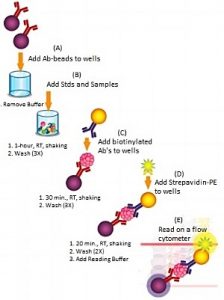Aimplex Biosciences Inc . is our companion for custom-made and premixed bead-based multiplex immunoassay technology. The panels are designed to be used with commonplace movement cytometers, so no costly particular gear is required. Approximately 400 immunoassays are at present provided within the quickly growing product portfolio.
How does AimPlex multiplex immunoassay technology work?
- Incubation step with antigen and seize antibody-conjugated bead (60 min.)
- Incubation step with biotinylated detection (30 min.)
- Streptavidin-PE incubation step (20 min.)
AimPlex multiplex immunoassay technology takes benefit of various populations of beads. They will be divided in accordance with dimension and fluorescence depth. There are two grades in dimension; four and 5 micron (4S and 5S). There are a complete of 12 ranges of fluorescence depth. This signifies that the technology from AimPlex Biosciences can concurrently detect as much as 24 analytes. This occurs in a single response with a pattern of solely 15µl.
The bead populations are then decided utilizing a typical movement cytometer. This requires a laser with both blue 488 nm and a crimson 635 nm or solely a 488 nm laser. The most emission of the bead classification dye is 700 nm.

The process itself is much like the sandwich ELISA process. A particular antibody is conjugated to every inhabitants of beads that captures the specified protein within the pattern like a cytokine. The quantity of analyte captured is detected by way of a biotinylated antibody in opposition to a secondary epitope of the protein, adopted by streptavidin-R-phycoerythrin remedy. The fluorescence depth of R-phycoerythrin on the bead is then measured on a traditional movement cytometer. Conclusions concerning the protein focus within the pattern can then simply be drawn from a comparability with the usual curve of the fluorescence alerts. The latter is obtained by serial dilution of a recognized focus of the protein to be examined.
At a look: Advantages of the bead-based multiplex immunoassay technology
- 2 bead sizes (4S and 5S)
- 12 fluority depth ranges for every bead dimension
- Can be used with standard movement cytometers (blue or crimson and blue lasers)
- Classic sandwich immunoassay format with seize (cAb) and detection (dAb) antibodies
- “Mix and match” choice
- Available in 32 and 96 take a look at kits
- Small pattern dimension (15µl)
- Faster (> 2h) and cheap immunoassay
Single-plex package parts
- Analyte package: analyte-specific Ab-conjugated beads, detection antibodies and corresponding antigen requirements
- Basic Kit: species-specific detection antibody diluent, studying buffer, wash buffer, streptavidin-PE (SAPE), filter plate and plate sealer
- Diluent package (pattern matrix-specific dilution package): sample-type-specific commonplace diluent and a pattern take a look at buffer
Premixed multiplex kits
Each premixed multiplex package has a predefined multiplex panel with premixed antibody-conjugated beads, antigens and detection antibodies. With the exception of the Reading Buffer (10x) and the Wash Buffer (10x), all reagents are equipped prepared to be used. Most premixed multiplex kits can be found in take a look at sizes 96 and 32.
Mix and match choice
All obtainable immunoassays are divided into 12 to 24 analytes per group. Each analyte in a gaggle has a singular bead area. Analytes from the identical group will be compiled in any mixture in accordance with the person analysis questions. Analytes in numerous teams will be put collectively, however can have a sure cross-reactivity. We are all the time obtainable to reply any questions you will have.


